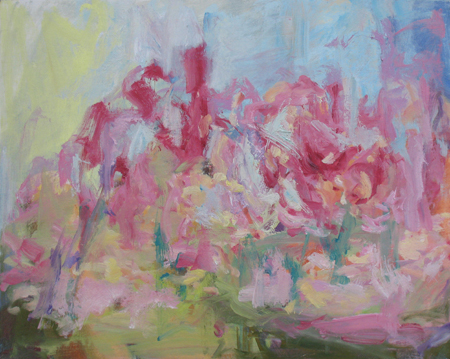My friend Phil, who lives outside Paris with his lovely wife Sally- and is a savant about art, poetry and music – said that my newest work reminded him of a Verlaine poem. Now knowing that Paul Verlaine was one of those flowery Symbolists, I wasn’t quite sure how to react. But after thinking it over and doing a little research on Mr. V, I discovered some of his poetry set to Claude Debussy’s music. A favorite composer, Debussy’s transition to his unique mature style emerged with these poems put to his notes. Voilà , a title for my painting.
Then too, in the spirit of Earth Day, this is a recycled work. Inspiration is from the huge tulip magnolia in my front yard, that drops all its pink petals almost as soon as they’ve bloomed.Â
Ariettes Oublieés, oil on canvas 24″x30″ 2009
from ‘All Music Guide’: The music is highly chromatic and tonally ambiguous, traits that Debussy would make his own in the next few years. Also, Debussy begins to make heavy use of the dominant ninth chord, one of his later trademarks; indeed, the very beginning of the first song is a series of falling ninths.
Debussy set Verlaine’s poetry 19 times through his career; the texts are rich in long, lazy vowels and seductively repetitive consonants. The first item in Ariettes oubliées is typical of Verlaine’s work and a highly adept musical setting by Debussy: the gauzy, floating melodic line perfectly reflects the text of C’est l’extase langoureuse, in all its languorous ecstasy.Â
From Erik Reischl: Paul Verlaine’s “Romances sans paroles†is a collection of poems written in 1874 during the vagabond period of his life which he shared with the poet Jean-Arthur Rimbaud. Symbolism influences the greater part of his work and is obvious here for the first time. Words become music, become tones and colours in the finest nuances and shades. In January 1885 Debussy began to write music for two of the poems after having been inspired by the musical quality of Verlaine’s poetry.
After winning the “Grand Prix de Rome†for his cantata “L’Enfant prodigueâ€, the young composer went to Rome only days later, where he was to remain for three years in the Villa Medici.
The separation from Madame Vasnier for whom he had written nearly all of his songs and the absence from his beloved city Paris were hard to bear. It is probable that the last four songs of the collection, written between 1885 and 1888, were to be a present for Madame Vanier when he returned.
The songs were originally published individually in 1888 under the title “Ariettesâ€. Debussy sent Mme Vasnier a copy of the first publication with a handwritten dedication. However he made a final dedication in the second publication which appeared as a complete collection in 1903 in a revised form and titled “Ariettes oubliéesâ€. On this occasion the recipient of the dedication was the soprano Miss Mary Garden, who had taken the role of Mélisande in the premiere of Debussy’s opera “Pelléas et Mélisandeâ€.
For the first time Ariettes oubliées adhered closely to the format of the poetry. There is no longer a repetition of texts found in the early Vasnier songs. The melismatic style gives way almost completely to a composing in which every syllable is represented by a note. Even the formal structure of Debussy’s songs adheres in its construction and content to each of the poems. This creates in “Il pleure dans mon coeurâ€, for example, a remarkable imbalance of the individual parts due to the thought processes in the text. Quite often Debussy focuses on important parts of the text by using recitative techniques (“Quoi! nulle trahison?â€), or by voicing a whole sentence on a single tone (at the beginning of “Spleenâ€).
Debussy lets music serve the word and through this he is able to achieve a musical analogy to Verlaine’s postulate.
Â
My old teacher and a concert pianist himself, Constantin Chatov, used to insist that all music was about sorrow, ecstasy and sex.


Well dayum! that might just be one of the most beautiful paintings I’ve ever seen.
You’re too kind….it is a little bit flowery 4 me. I had to walk away fast before I ruined it.
Pingback: Victoria Webb - Furious Dreams. Painter, Designer, Activist » Blog Archive » Exhibit - Wayne Art Center